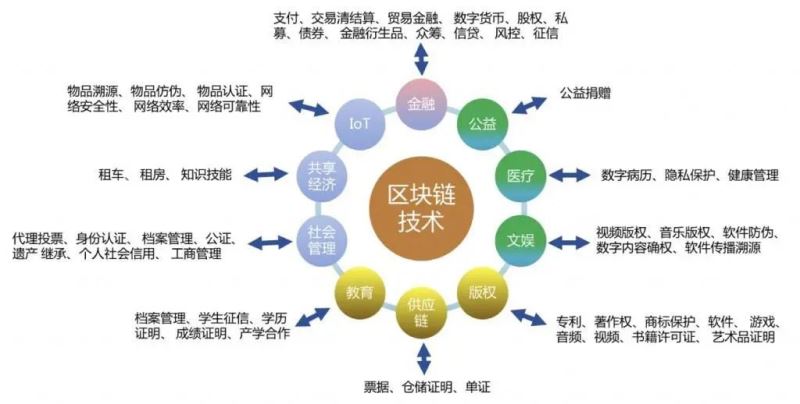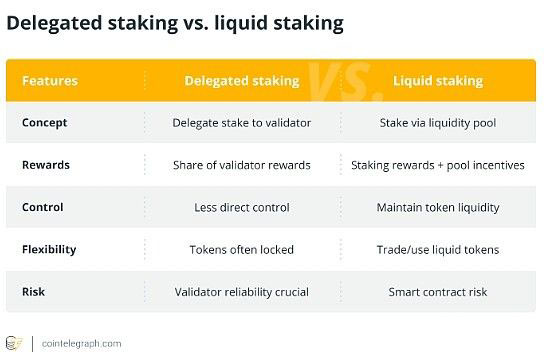What do you understand about liquidity staking? How does it work?
What is liquidity staking? How does it work? What is the difference between liquidity staking and entrusted staking? Liquid staking allows stakers to maintain the liquidity of their staked tokens through the use of alternative tokens, which they can use to earn additional income through DeFi protocols.
Today, the editor of this website will introduce to you in detail what is liquid staking? How liquidity staking works, and the difference between liquidity staking and entrusted staking. Hope you all like it!

1. What is liquidity staking?

Liquid staking allows stakers to maintain the liquidity of their staked tokens by using alternative tokens, which they can use to earn additional income through DeFi protocols.
Before we dive into liquidity staking, let’s first understand staking and the issues associated with it. Staking refers to the process of locking cryptocurrency in a blockchain network to maintain it, which enables stakers to earn profits. However, pledged assets often become illiquid during the staking period as they cannot be traded or transferred.
Liquidity staking enables cryptocurrency holders to participate in staking without giving up control of their holdings. This changes the way users perform staking. Projects such as Lido have introduced liquidity staking, providing tokenization of pledged assets in the form of tokens and derivatives.
It allows users to gain the advantages of staking while retaining the flexibility to trade these tokens in decentralized finance (DeFi) applications or transfer them to other users.

#2. Is there a difference between entrusted staking and liquidity staking?
Network users in Delegated Proof of Stake (DPoS) vote to choose their preferred delegator. However, the purpose of liquid staking is to allow stakers to circumvent minimum staking thresholds and mechanisms to lock up tokens.
Although DPoS borrows the basic concept of Proof of Stake, the way it is executed is different. In DPoS, network users have the power to elect representatives called “witnesses” or “block producers” to validate blocks. The number of representatives participating in the consensus process is limited and can be adjusted by voting. Network users in DPoS can pool their tokens into a staking pool and use their combined voting power to vote for preferred representatives.
Liquidity staking, on the other hand, aims to lower the investment threshold and provide stakers with a way to circumvent the token locking mechanism. Blockchains often have minimum requirements for staking. For example, Ethereum requires anyone who wants to set up a validator node to stake at least 32 Ethereum (ETH). It also requires specific computer hardware, software, time and expertise, which in turn requires significant investment.

3. What is staking as a service?
Staking-as-a-Service is a platform that acts as an intermediary, connecting the blockchain’s consensus mechanism with cryptocurrency holders who wish to contribute to the functionality of the network.
Staking-as-a-Service is a platform or service that enables users to entrust their crypto assets to a third party, who then participates in staking on the user’s behalf, typically charging a fee or sharing in rewards. According to JPMorgan Chase, the pledge services industry will expand to $40 billion by 2025. Cryptocurrency staking services will play an important role in this emerging economy, and liquidity staking will become an integral part of it.
Staking-as-a-service platforms can be classified into custodial and non-custodial based on the degree of decentralization, which plays an important role in safeguarding the best interests of stakeholders and maintaining transparency. To facilitate decentralized governance, key decisions are made by Decentralized Autonomous Organizations (DAOs).
Managed Staking as a Service involves extensive management of the staking process. The staking services provided by cryptocurrency exchanges are custodial. Rewards flow first to staking providers and then to stakers.
In a non-custodial staking-as-a-service model, validators charge a commission to anyone who wants to participate in staking. In PoS networks that support native delegation, stakers’ reward shares are sent directly to them without the involvement of validators.
4. How Liquidity Staking Works
Liquidity Staking aims to eliminate the staking threshold and allow holders to profit from liquidity tokens.
The staking pool allows users to combine several small pledges into one large pledge using smart contracts, which provide each staker with corresponding liquid tokens (representing their share of the staking pool).
This mechanism eliminates the threshold for becoming a staker. Liquid staking goes a step further, allowing stakers to double their returns. On the one hand, they earn from the staked tokens, and on the other hand, they earn from the liquidity tokens by conducting financial activities such as trading, lending or any other activities without affecting their original staked positions. profit.
Using Lido as a case study will help us better understand how liquidity staking works. Lido is a liquid staking solution for PoS currencies, supporting multiple PoS blockchains including Ethereum, Solana, Kusama, Polkadot, and Polygon. Lido provides an innovative solution to the barriers posed by traditional PoS staking by effectively lowering the barriers to entry and costs associated with locking assets in a single protocol.

#Lido is a staking pool based on smart contracts. Users who deposit assets into the platform will stake them on the Lido blockchain through the protocol. Lido allows ETH holders to stake a fraction of the minimum threshold (32 ETH) to earn block rewards. After depositing funds into Lido's staking pool smart contract, users receive Lido Staked ETH (stETH), an ERC-20 compatible token that is minted on deposits and destroyed on withdrawals.
The protocol distributes staked ETH to validators (node operators) within the Lido network, which is then deposited into the Ethereum beacon chain for verification. These funds are then protected by a smart contract, which is inaccessible to validators. ETH deposited through the Lido staking protocol is divided into sets of 32 ETH among active node operators on the network.
These operators utilize public verification keys to verify transactions involving user-staking assets. This mechanism allows users’ staked assets to be spread across multiple validators, thereby reducing the risks associated with single points of failure and single validator staking.
Stakers who deposit Solana (SOL) tokens, Polygon (MATIC), Polkadot (DOT), and Kusama KSM via a set of smart contracts in Lido will receive stSOL, stMATIC, stDOT, and stKSM respectively. stToken can be used to earn DeFi yields, provide liquidity, trade on decentralized exchanges (DEX), and many other use cases.
5. Are there any risks in the liquidity staking platform?
As with any product or service in the cryptocurrency space, technical threats and market volatility need to be considered when dealing with liquidity staking.
Technical Threats
PoS blockchain is still relatively new, and there is always the possibility of protocol errors or vulnerabilities that could lead to assets being lost or exploited. Relying on validators for staking also creates counterparty risk.
Market Risk
Liquidity staking unlocks staked assets, allowing stakers to earn rewards from DeFi applications. However, this also brings the risk of losing ground on both fronts during market downturns.
Keeping the liquidity staking platform open source and regularly audited can help prevent threats to a certain extent. Having a bounty program for the platform can also help minimize bugs.
Conducting comprehensive due diligence is critical to addressing the risks associated with market volatility. This includes studying historical market data, assessing the financial health of potential investments, understanding the regulatory environment, and developing a diversified investment strategy.
The above is the detailed content of What do you understand about liquidity staking? How does it work?. For more information, please follow other related articles on the PHP Chinese website!

Hot AI Tools

Undresser.AI Undress
AI-powered app for creating realistic nude photos

AI Clothes Remover
Online AI tool for removing clothes from photos.

Undress AI Tool
Undress images for free

Clothoff.io
AI clothes remover

Video Face Swap
Swap faces in any video effortlessly with our completely free AI face swap tool!

Hot Article

Hot Tools

Notepad++7.3.1
Easy-to-use and free code editor

SublimeText3 Chinese version
Chinese version, very easy to use

Zend Studio 13.0.1
Powerful PHP integrated development environment

Dreamweaver CS6
Visual web development tools

SublimeText3 Mac version
God-level code editing software (SublimeText3)

Hot Topics
 Which of the top ten currency trading platforms in the world are the latest version of the top ten currency trading platforms
Apr 28, 2025 pm 08:09 PM
Which of the top ten currency trading platforms in the world are the latest version of the top ten currency trading platforms
Apr 28, 2025 pm 08:09 PM
The top ten cryptocurrency trading platforms in the world include Binance, OKX, Gate.io, Coinbase, Kraken, Huobi Global, Bitfinex, Bittrex, KuCoin and Poloniex, all of which provide a variety of trading methods and powerful security measures.
 What are the top ten virtual currency trading apps? The latest digital currency exchange rankings
Apr 28, 2025 pm 08:03 PM
What are the top ten virtual currency trading apps? The latest digital currency exchange rankings
Apr 28, 2025 pm 08:03 PM
The top ten digital currency exchanges such as Binance, OKX, gate.io have improved their systems, efficient diversified transactions and strict security measures.
 What currency does Ripple (XRP currency) belong to? Detailed tutorial for beginners
Apr 28, 2025 pm 07:57 PM
What currency does Ripple (XRP currency) belong to? Detailed tutorial for beginners
Apr 28, 2025 pm 07:57 PM
Created by Ripple, Ripple is used for cross-border payments, which are fast and low-cost and suitable for small transaction payments. After registering a wallet and exchange, purchase and storage can be made.
 Binance official website entrance Binance official latest entrance 2025
Apr 28, 2025 pm 07:54 PM
Binance official website entrance Binance official latest entrance 2025
Apr 28, 2025 pm 07:54 PM
Visit Binance official website and check HTTPS and green lock logos to avoid phishing websites, and official applications can also be accessed safely.
 Which of the top ten currency trading platforms in the world are among the top ten currency trading platforms in 2025
Apr 28, 2025 pm 08:12 PM
Which of the top ten currency trading platforms in the world are among the top ten currency trading platforms in 2025
Apr 28, 2025 pm 08:12 PM
The top ten cryptocurrency exchanges in the world in 2025 include Binance, OKX, Gate.io, Coinbase, Kraken, Huobi, Bitfinex, KuCoin, Bittrex and Poloniex, all of which are known for their high trading volume and security.
 What are the top currency trading platforms? The top 10 latest virtual currency exchanges
Apr 28, 2025 pm 08:06 PM
What are the top currency trading platforms? The top 10 latest virtual currency exchanges
Apr 28, 2025 pm 08:06 PM
Currently ranked among the top ten virtual currency exchanges: 1. Binance, 2. OKX, 3. Gate.io, 4. Coin library, 5. Siren, 6. Huobi Global Station, 7. Bybit, 8. Kucoin, 9. Bitcoin, 10. bit stamp.
 Sesame Open Door Official Website Entrance Sesame Open Door Official Latest Entrance 2025
Apr 28, 2025 pm 07:51 PM
Sesame Open Door Official Website Entrance Sesame Open Door Official Latest Entrance 2025
Apr 28, 2025 pm 07:51 PM
Sesame Open Door is a platform that focuses on cryptocurrency trading. Users can obtain portals through official websites or social media to ensure that the authenticity of SSL certificates and website content is verified during access.
 Top 10 cryptocurrency apps recommended in 2025 Virtual currency trading platform app rankings
Apr 30, 2025 am 10:33 AM
Top 10 cryptocurrency apps recommended in 2025 Virtual currency trading platform app rankings
Apr 30, 2025 am 10:33 AM
Recommended top ten cryptocurrency apps in 2025: 1. OKX, 2. Binance, 3. Coinbase. 1. OKX ranks first with its powerful features and user-friendly interface, supporting a variety of transactions and staking services. 2. Binance ranks second with its huge user base and rich trading pairs, providing a variety of trading and IEO services. 3. Coinbase ranks third with its user-friendly interface and powerful security measures, supporting a variety of mainstream virtual currency transactions.





